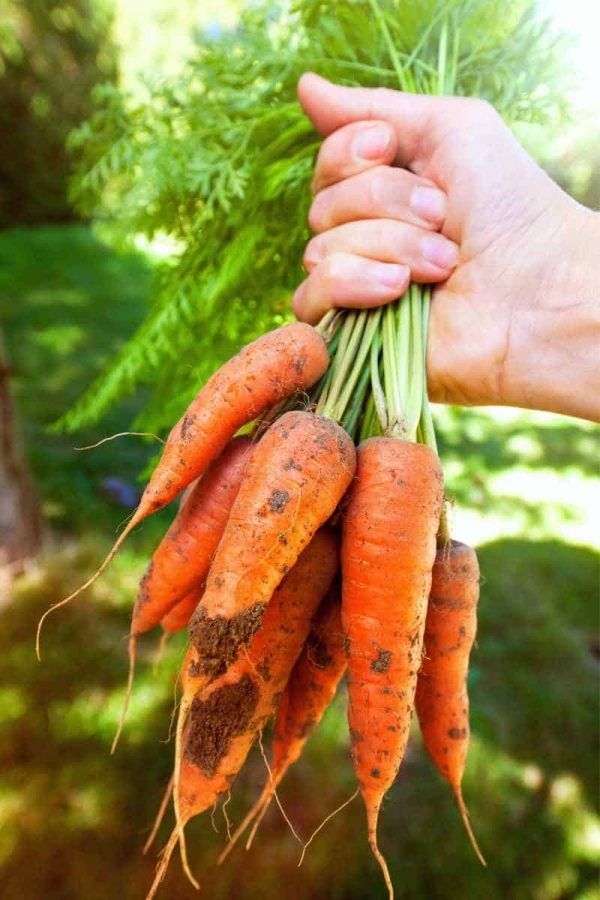Carrots (Daucus carota) are one of the simplest root crops to grow! With just a few tips, you can grow a beautiful spectrum of colorful carrots that taste better than what you get in the grocery store, are packed with more vitamins and nutrition, and give you the satisfaction of knowing you grew them!
Garden carrots are wonderful because they “hold” in the vegetable garden for a long time—in many climates, you can even store them in the ground under mulch for the winter—making them a great crop with a long harvest season that you and your family can enjoy for months and months. Let’s get growing!
Table of Contents
Are carrots easy to grow?
Yes! It’s extremely easy to learn how to grow carrots, even if you’re new to gardening. The key to growing excellent carrots is preparing your soil ahead of time. This gives the carrot roots the proper growing environment. The trickiest part of growing carrots is dealing with the tiny seeds and thinning them out, but we’ll get to that in a bit.
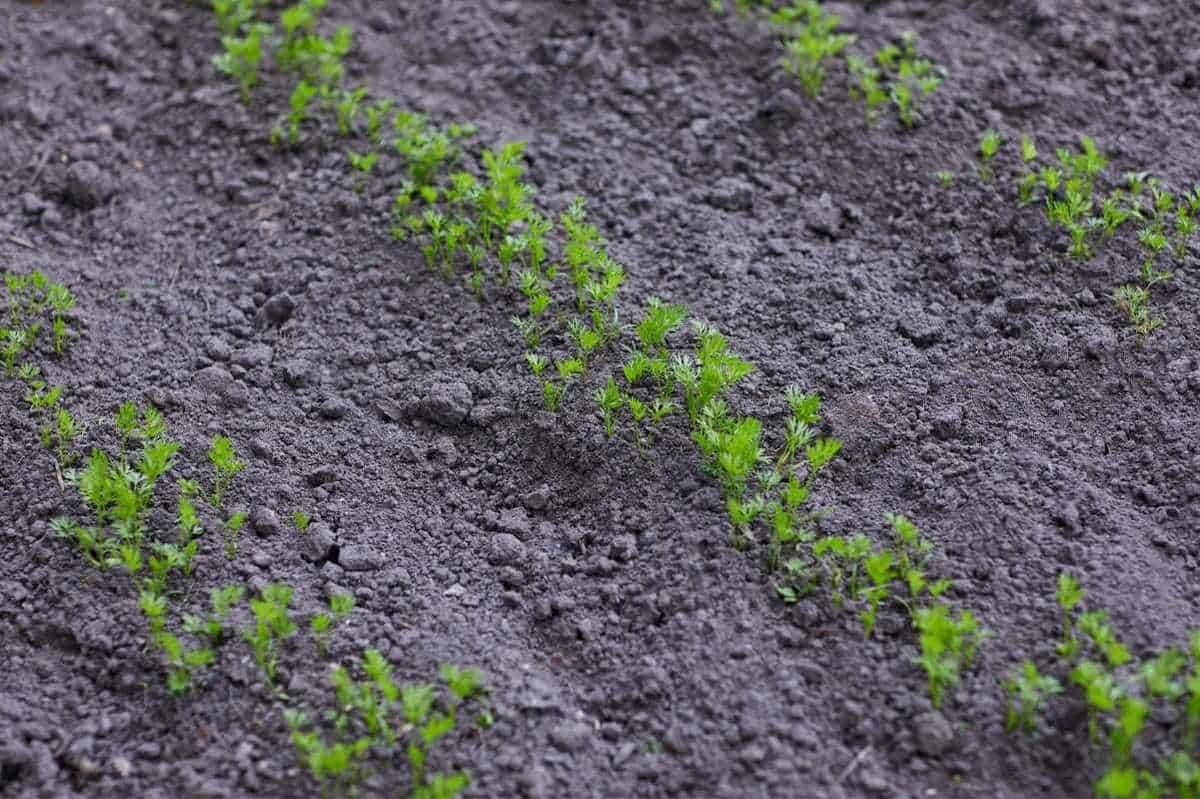
In what month do I plant carrots?
Carrots are a cool-season crop, meaning they can grow in both spring and fall in most growing zones. This also means they can be grown in climates with shorter growing seasons. They are also excellent candidates for succession planting.
Spring Planting: Carrots need a soil temperature of 65-80°F to germinate. Plant your carrots in the spring as soon as you can work the ground. Check your local frost dates for your growing zone and plant your carrot seeds three weeks before the last frost.
Fall Planting for Fall Harvest: In many growing zones, you can get a second crop of carrots heading into fall. Plant your carrot seeds eight weeks before your first frost date.
Fall Planting for Spring Harvest: You can also plant under a thick layer of mulch, as carrots are a great option for overwintering in all except the coldest of growing zones. To overwinter for spring harvest, plant carrot seeds four to six weeks before your first fall frost. Once the cold sets in for the fall, cover the carrots in a thick layer of mulch (3-4″ in mild climates, 6+” in colder climates). Come spring, as the soil and air temperatures warm up, your carrots will start to regrow quickly, and you’ll be harvesting carrots before you know it!
Growfully Protip
Carrots get noticeably sweeter after they’ve been touched by a frost. Fall carrots and overwintered carrots are some of the best carrots you’ll ever taste!
How long does it take to grow carrots?
Carrots are a relatively quick-growing vegetable and they can be harvested at any stage of their growing process—pulling up and snacking on a baby carrot is always a fun way to check your carrot progress. It takes carrots at least a week to germinate; however, it might take even longer if the soil is cold. After germination, you can expect to have carrots in about 70 days (more or less depending on the variety—check your seed packet).
Growfully Protip
Try succession planting to extend your carrot harvest. Plant a few carrot seeds and then plant another batch a few weeks later. Succession planting ensures a steady supply of carrots throughout the summer. It will also prevent you from becoming overwhelmed by too many carrots all at once.

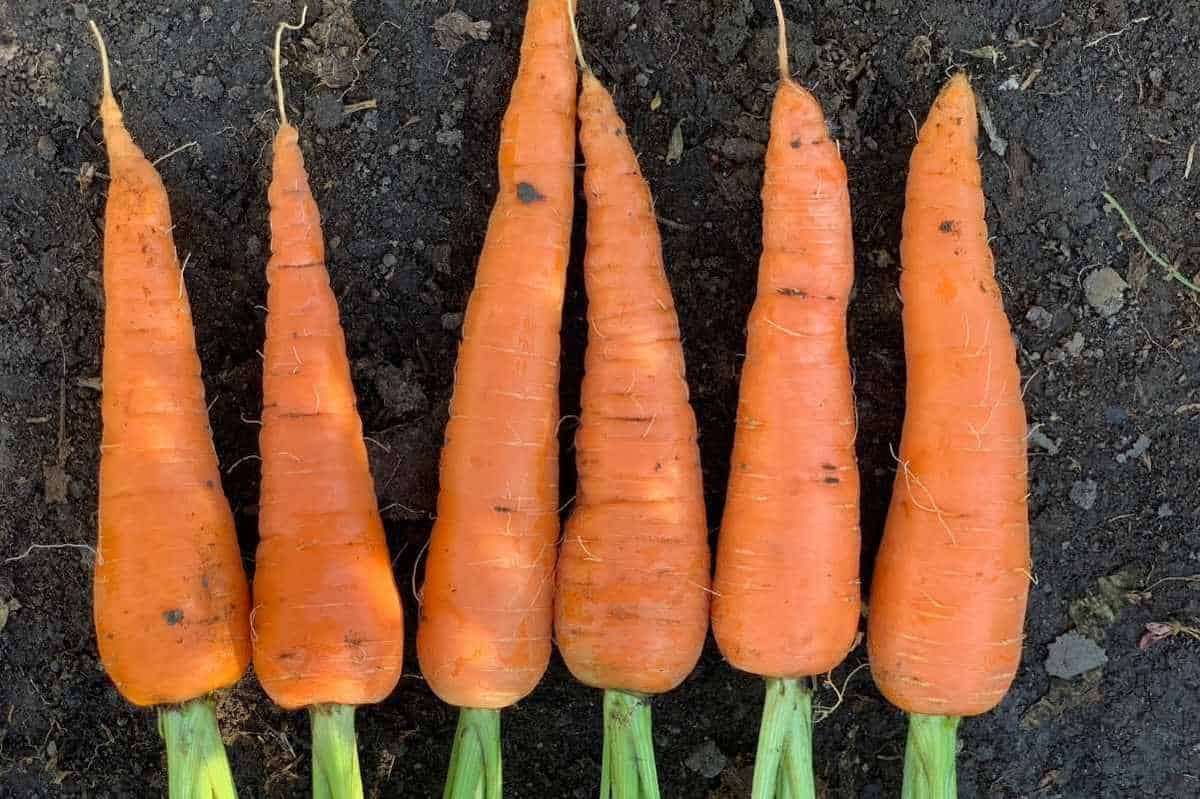
Families of carrots—which carrot varieties to grow
Carrots come in all different sizes, shapes, and even colors! Each type works for a particular soil, growing season, and use. There are four major families of carrots, and within each category, there are tons of varieties to choose from. Here are the families:
- Danvers—This family of carrots are what you probably picture when you think of a carrot. They are medium length—six to seven inches—with a dark orange coloring. They have round tops and come to a point at the end. Danvers carrots are great for harder soils, and they are excellent storage varieties.
- Imperator—These carrots can grow extremely long—upwards of 10 inches—and they’re very sweet. Their long, skinny shape requires very loose soil that’s been dug deep. Grown in heavier soils, Imperator carrots twist and become stunted. They’re perfect for eating fresh because of their high sugar content.
- Nantes—Nantes carrots are sweet and perfect for juicing and eating fresh. Unlike the traditional carrot, Nantes are cylindrical and smooth, with the same diameter from root to stem. Their tips are blunt, and they grow best in loose, well-drained soil.
- Chatenay—If you have thick, rocky, or heavy soil, choose a Chatenay carrot. They’re much shorter than the other varieties, and their strong roots can push through almost any kind of soil. Chantenay carrots are some of the best for freezing and canning. Thumbelina (AKA: Parisian) is a fun Chatenay baby carrot about the size and shape of a pudgy thumb (hence the name). Since these carrots are so short, they are great for where you have hard soil or containers. They also have a tender skin that doesn’t need to be peeled.
What are the best carrots to plant?
In our garden, we always grow Scarlet (Nantes type), Napoli (Nantes type), and Thumbelina (Chatenay).

Do carrots need full sun?
Carrots are best grown in full sun; however, they will tolerate light shade—especially in hotter climates. To give your carrots the best possible growing conditions, make sure that their site is in an area that receives six to eight hours of direct sunlight a day.
Best conditions for growing carrots
Carrots need loose, well-drained, sandy soil to grow correctly. Carrots prefer warm tops and cool roots. This means they’ll likely need a layer of mulch around the tops to keep the roots cool if the temperature warms up. Carrots need six to eight hours of sunlight a day, and roughly an inch of water a week as they grow.
Growfully Protip
If your soil isn’t loose enough, carrots will grow crooked, bent, woody, and “hairy” (lots of small roots from the main root). It is imperative that carrot soil be soft and loose a full 10-12 inches in depth.

Where should I plant my carrots?
Carrots need to be grown in loose, well-drained soil. We prefer no-till methods, which can take many growing seasons to create loose enough soil for carrots (especially when starting with clay soil).
If you want to prepare your soil now, till or fork your soil down a foot deep. Make sure you break up any large clumps of soil and remove any large rocks, stones, and roots. If your soil is heavy or full of clay, you may be better off growing your carrots in raised beds. Raised beds allow you to control the composition of your soil so your carrot’s roots can grow long and strong.
Growfully Protip
When preparing your garden bed, avoid adding nitrogen-rich fertilizer or manure to the area you’re planting your carrots. High levels of nitrogen will cause your carrots to fork out instead of growing straight down. A balanced fertilizer or organic matter (like well-rotted compost) is a better option.
Should I start my carrots indoors?
Nope! You can’t transplant carrots. They’re too tiny, their roots are too fragile, and they won’t survive.
If you’re trying to get a head start on your carrot crop, you can always warm your soil using a piece of black plastic or gardening cloth.
Alternatively, you can plant carrots in deep containers (5-gallon buckets with holes drilled in the bottom or 5-gallon grow bags are good options) and keep them inside under grow lights, and then move the containers outside once the weather has warmed.
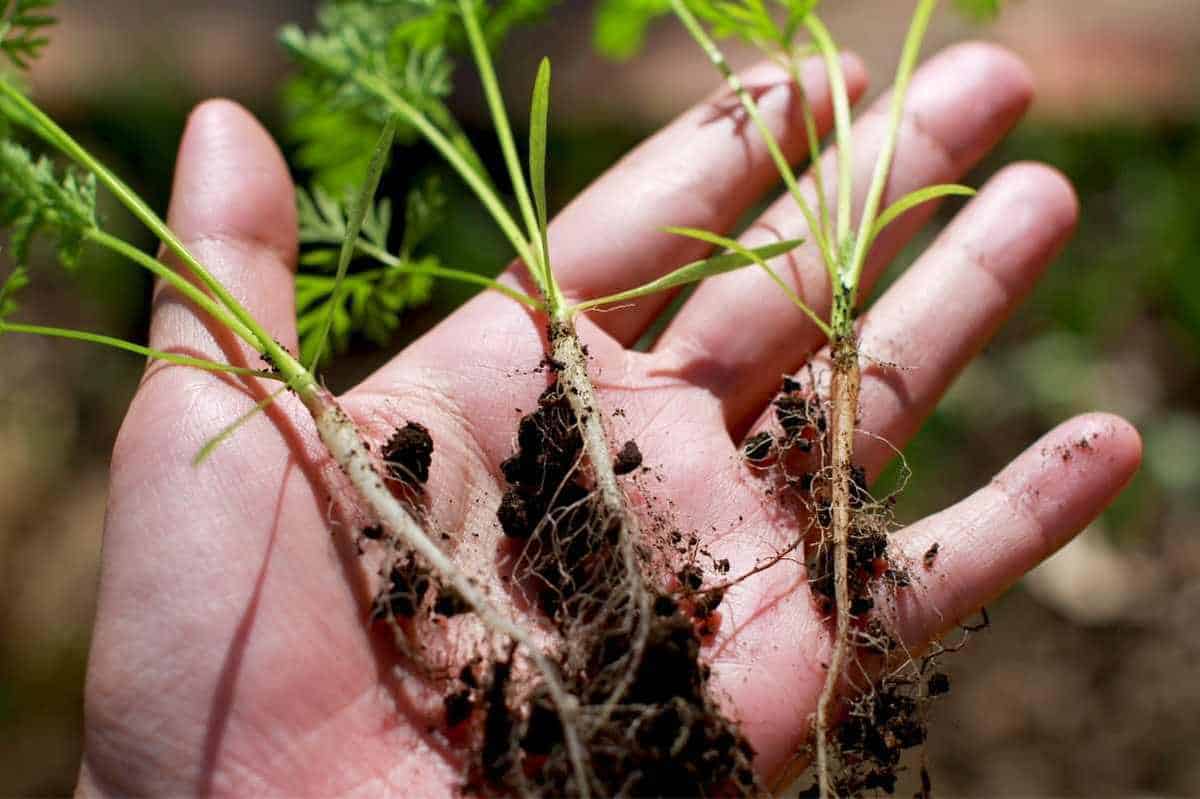
What’s the best way to sow tiny carrot seeds?
Carrot seeds are notoriously difficult to work with because they’re so tiny. You could try using pelleted seed (seeds that are coated in a water-soluble layer that makes them bigger and easier to handle), but this convenience comes with a steeper price tag. This leaves two primary methods for sowing carrot seeds:
- Our preferred method is to mix them with dry coffee grounds to encourage carrot seed separation (some folks recommend using vermiculite for this, but we no longer recommend that due to the risk of asbestos exposure) and then either broadcasting them widely over a large area or sprinkling them in rows. This method is easier at the sowing stage, but it requires more work when it comes to thinning your carrot seedlings (which is a must, more on that in a sec).
- You can also sow carrot seeds individually by hand. You can get relatively inexpensive tools that help one seed come out at a time. You can also do this yourself by rolling them in between your fingers as you move along your row so that only one or two seeds come out at a time. This is incredibly tedious, but this method will make thinning your carrots easier.
Growfully Protip
We’ve tried just about every method for sowing carrots in the Growfully Gardens, and we come back to the same one every time—mix with dry coffee grounds, broadcast widely, and then thin when the carrots are large enough. The thinning can be tedious, but with a good pair of scissors and some nice weather, it can be almost meditative work (and you only have to do it once).
How to grow carrots from seed
Like most root vegetables, carrots do not like having their roots disturbed, so it’s best to direct sow them in the soil. Prepare your growing site as early as possible—preferably the fall before—to give your carrots the best possible start.
Once you’ve picked a sunny location with good soil, it’s pretty easy to grow carrots.
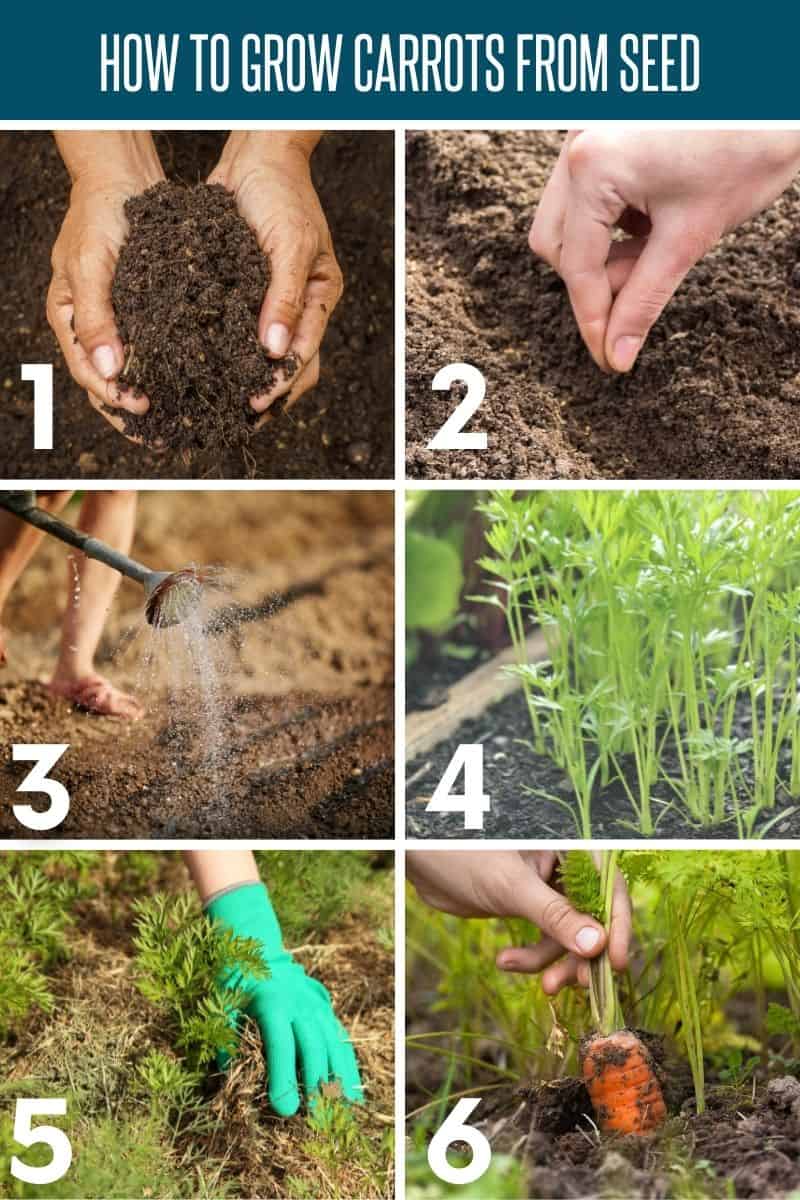
- Prepare your soil. Deep dig the area of your garden bed where you want your carrots to grow—at least 10-12″ for typical-sized carrots. Ensure there are no large obstructions, such as roots, rocks, or hard clay. If your soil is heavy or clay, we recommend adding sand and organic matter to improve soil condition and keep the soil loose.
- Sow seeds. Using your preferred method from above, sow your carrots seeds just on the surface of the soil. We prefer sprinkling the seed on top, and then sprinkling a fine layer of soil over top of the seeds.
- Keep the soil moist. This is an absolute must when it comes to growing carrots. The soil needs to remain moist at all times while you await carrot germination. If the soil dries out and crusts over, the carrot sprouts are too small to break through. This is the #1 cause of low germination rates in carrots. Some folks even put a board, plastic, or other protective covering over the carrots seeds to keep them damp and out of the sun—then immediately remove it once germination has begun.
- Thin the seedlings. Many people skip this step and then wonder why their carrots are small, twisted, and rooty—this is why! Carrots can grow relatively close together, but they do need enough space to grow thick and long. Once the carrot tops are 1-2″ long, you want to thin them so there’s an inch of space between each carrot plant. But don’t pull them! This can easily disturb the roots of the carrots you want to keep. Instead, use a sharp pair of garden scissors to cut the extra seedlings at dirt level.
- Keep the carrots weeded and watered. Once the carrot tops are 2-3″ long, you can put a layer of mulch on top of the carrots to keep moisture levels consistent and weeds at bay. As long as you have rich soil, you shouldn’t need to fertilize your carrots, but if you want to give them a boost of a balanced fertilizer (like fish emulsion and/or liquid kelp) every 6 weeks, you can.
- Carrots are ready to harvest as soon as they are big enough for you to enjoy! To know when they are ready, you can either just pull one or root around in the top of the soil to see how large the top of the root its. Check your seed packet for the final size of your particular carrot variety.
Growfully Protip
Carrot germination can be incredibly slow and erratic. In perfect conditions, you’ll see your carrots popping through in 7 days, but don’t be surprised if it takes closer to 14-21 days for all of your carrot seeds to make their debut.

How to grow carrots in containers
Carrots make good candidates for container planting because of their preference for sandy soils. Creating the loose soil your carrots need in a controlled environment can be a lot easier. Make sure that whichever container you choose has drainage holes at the bottom. Carrots dislike wet roots. We’ve had great success growing carrots in affordable grow bags.
The diameter of your pot doesn’t matter as much as the depth. Grow your carrots in a pot that’s at least 14 inches deep. Follow the same method as planting as above. As a general rule, you can fit 25 carrots in a five-gallon container, while you can fit five carrots in a one-gallon pot. This varies a bit depending on the orientation of the container (shallow versus tall, etc.)
How to grow carrots using square foot gardening
Square foot gardening is a concept designed to grow more food in less space. Instead of planting your carrots in rows, you plant them in square foot sections. As the carrot tops break through the surface, they’re packed so closely together that weeds have a hard time finding room to grow.
If you decide to square foot garden your carrots, prepare the soil the same way you would if planting in rows. Then, plant 16 carrot seeds evenly spaced apart in your square. You can eyeball this, get handy guides for it online (we use this seeding square in our garden), or make a guide yourself by cutting a square of wood—one foot by one foot—and drilling 16 holes.

How do I care for my growing carrots?
Carrots require minimal effort during the growing season. You can pretty much leave them to their own devices. That said, they have some simple requirements that need to be met to stay healthy.
Weeding carrots
It’s challenging to weed carrots because pulling the weeds can lead to yanking the carrots up by mistake. Use a thick layer of straw or mulch around the tops of your carrots after they’ve germinated to keep the weeding you need to do to a minimum.
If you do need to weed while the carrots are still small, you can use a sharp, small hand hoe to gently remove weeds or clip them at the surface with scissors (they will probably come back).
Once the carrots have established some sturdy roots, they aren’t quite as fragile and you can pull most weeds without disturbing your carrot crop.
Watering carrots
This is the most important step in keeping carrots healthy. While germinating, they need their soil to stay moist and you need to water the ground gently every day. After germination, they need a moderate amount of water—roughly one inch a week as the roots mature. Carrots do not like soggy roots, so make sure your soil drains well and let the soil dry out a bit between waterings.
Fertilizing carrots
You might not need to fertilize your soil if it was nutrient-rich when you planted your carrots. If you do fertilize, avoid any high-nitrogen fertilizers that encourage foliage growth and hairy roots. Instead, every six weeks or so starting after germination, use a gentle, balanced fertilizer (we like fish-emulsion and liquid kelp) to give your carrots a boost.
Growfully Protip
Have furry carrots? Excess water and excess nitrogen as well as tough soils can cause carrots to produce a lot of side roots, making them look furry. Scale back on the watering and fertilizing and make sure your soil is loose and well-dug before your next crop of carrots.
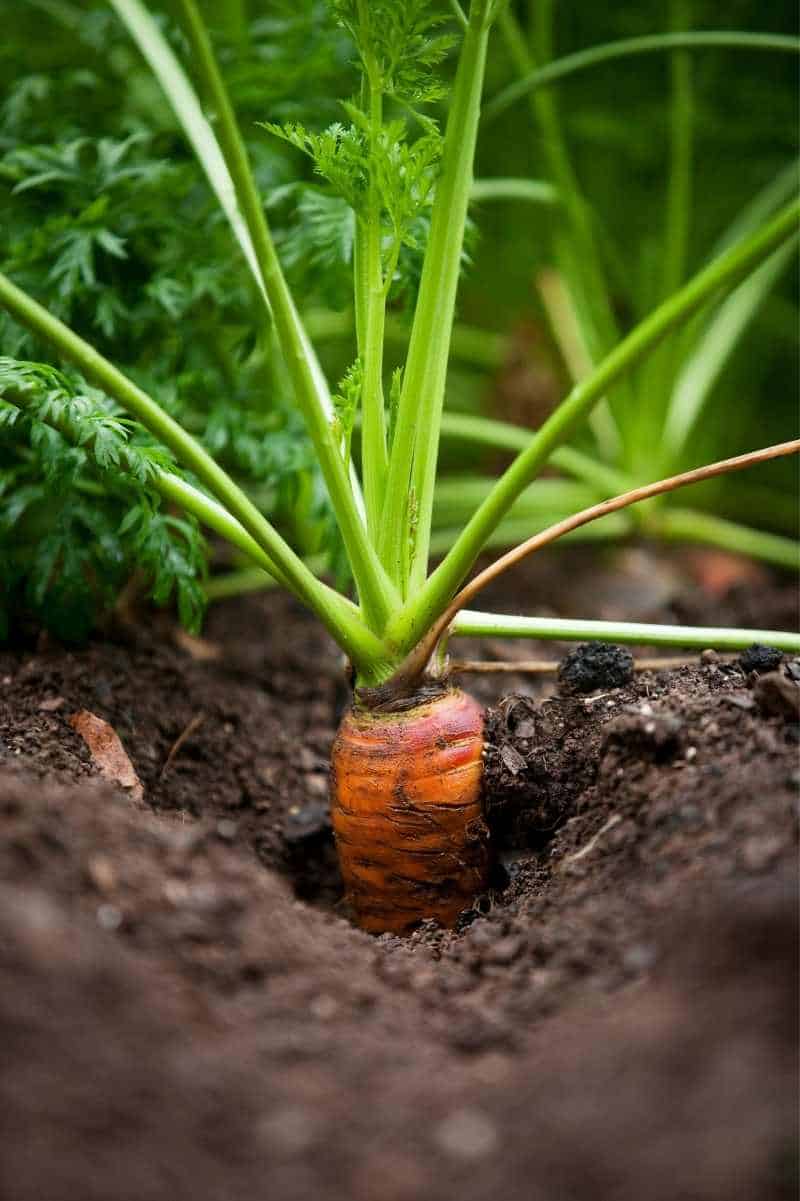
How many carrots do I need to plant?
Unlike other plants that grow multiple vegetables from a single plant, carrots grow one per seed. The general recommendation is to plant 48 carrots for every family member. Increase this number if you plan on storing, freezing, or canning your carrots.
Growfully Protip
We recommend planting more than you think you’ll need for three reasons. 1) Pulling carrots is one of the only ways to gauge their growth. 2) Carrots make a great gardening snack! 3) If you have kids out in the garden with you, they will pull carrots—it’s great fun when you’re a little one!
Plant rotation for carrots
You can cut down on diseases and pests in your garden by rotation planting. Next year’s garden will also benefit from crop rotation.
Carrots push through the soil and break it up. They can follow pretty much any other plant because they’re light to medium feeders.
Tomatoes benefit from the loose soil carrots provide, so they’re an excellent choice to follow carrots in your rotation planting schedule. You could also follow carrots with onions or legumes.

Companion plants for carrots
Some plants make great neighbors for your carrot plants by enriching their flavor, attracting beneficial insects, or scaring away pests that might harm your plants. The following are some of the best companion plants for carrots.
- Leeks, chives, and onions—Members of the onion family help repel aphids and carrot flies. Carrots, in turn, benefit leeks by repelling leek moths. Chives may help improve the sweetness of your carrots.
- Radishes—Interplanting radish seeds with your carrots can help break up the soil. Radishes are harvested before carrots. As they grow, they’ll break the hard crust on the soil’s surface, allowing the delicate carrot tops to poke through. You can also use radishes to mark the start and end of carrot rows. Radishes germinate very quickly, which gives you a good row marker while you wait for slow-germinating carrots to pop through.
- Rosemary and sage—These fragrant herbs can help repel the carrot rust fly.
- Nasturtiums—Nasturtiums help repel carrot pests such as aphids and cucumber beetles.
- Tomatoes—Carrots help repel the tomato hornworm and other tomato plant pests. It’s important to note that growing tomatoes and carrots together can improve the flavor of both, but it may make your carrots smaller.
Just as some plants make good companions, others do not. Avoid planting the following plants near your carrots.
- Parsnips compete for the same soil nutrients as carrots—it’s a good idea to plant your root vegetables apart from one another to limit this competition. Parsnips also attract the same pests as carrots, so it’s best to keep these two separate when possible.
- Fennel attracts a wide variety of pests. It’s best to plant it far from your garden, where it will attract the pests away from your vulnerable carrots.
- Dill can stunt the growth of your plants by giving off a compound that’s harmful to carrots.
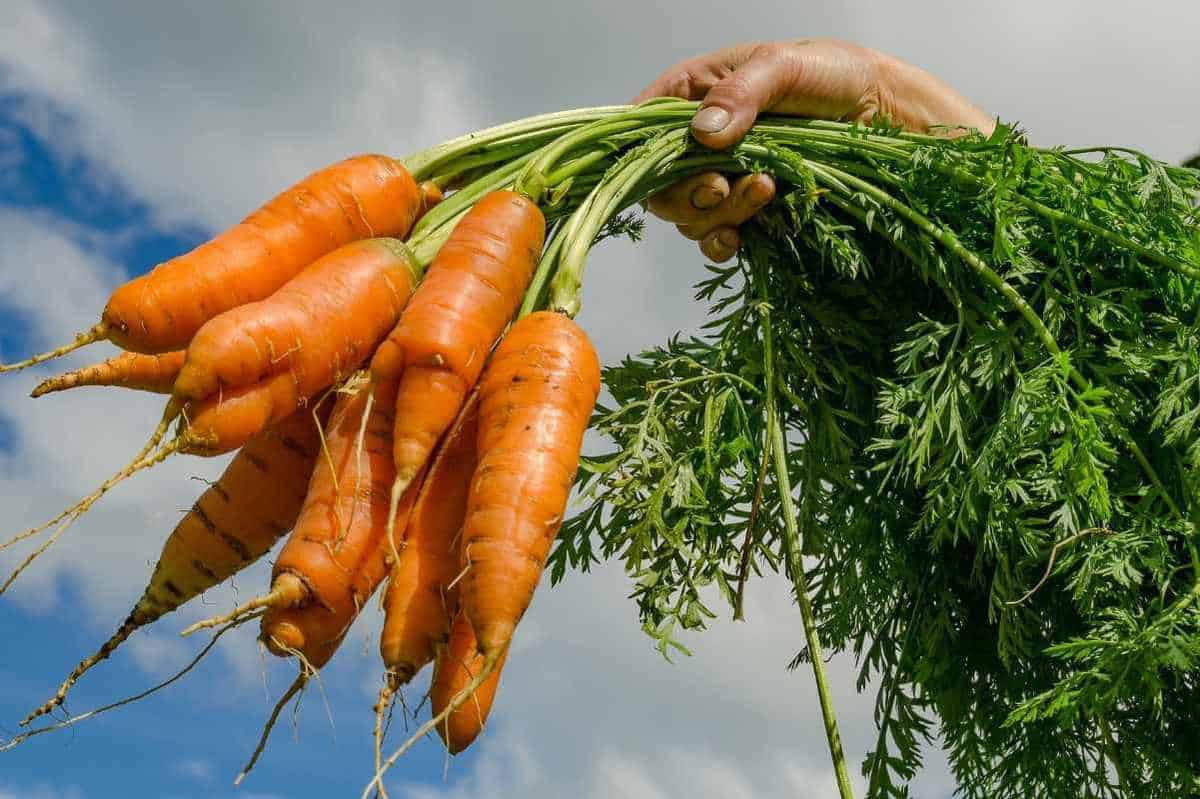
Troubleshooting
Prevention goes a long way in managing carrot disease and pests. Cleaning up your garden in the fall, rotation planting your crops, careful companion planting, and excellent weed control will all drastically reduce carrot problems.
Carrot pests:
- Carrot fly—These flies can cause root rot, rusty tunnels through carrots, and stunted growth. You can catch adults in yellow sticky traps. Crop rotation, cleaning up last year’s garden, and encouraging beneficial insects will help prevent this pest.
- Leafhoppers—Leafhoppers shed their white skin on your carrot leaves. They may cause holes in the foliage and stunted yellow/brown curled leaves. If you see some adults, you can trap them in yellow sticky traps or shake them off the leaves by using a powerful stream of water. A good layer of mulch and proper cleaning of your previous year’s garden will discourage these insects.
- Flea beetles—This insect leaves tiny holes in the leaves of your carrots. Encouraging beneficial insects, using mulch, and covering your carrots with floating row covers discourages flea beetles.
- Wireworms—This pest bores holes in the roots of your carrots as it eats them. Crop rotation and good soil drainage can prevent wireworms from infesting your carrot crop. If you suffer from an infestation, dig several holes two to four inches deep and fill them with a mix of germinating peas, corn, beans, or potato sections. This acts as bait, drawing the pests. Cover the trap with a board and uncover and destroy the wireworms one week later.
- Root-knot nematodes—Root-knot nematodes cause stunted growth and warped or forked root development in your carrots. Preventing this pest is key. Clean up the previous year’s garden, destroy any garden waste properly, clean your tools, and rotate your crops.
Carrot diseases:
- Black Canker—A fungus that forms on the shoulders of carrots poking up above the ground. It can turn the root red, orange, purple, or black while leaving orange spots on the leaves. Keep the soil around the shoulders of your carrots mounded up, so they’re not exposed to the air. Proper crop rotation and choosing a resistant carrot variety will cut down on the changes of this fungus spreading.
- Aster yellow disease—A bacteria that causes bitter-tasting carrots, stunted growth, and hairy roots. It’s spread by insects and pests. This disease can overwinter in the soil, so crop rotation is essential. Proper weeding can help prevent this disease from taking hold.
Overwintering carrots
My #1 favorite crop to overwinter is carrots—they get so sweet and tender! Sow carrot seeds in the fall, and mulch heavily. In areas with mild winters, this should be plenty of protection. In colder climates, consider using a low tunnel or cold frame to keep the soil warmer. Harvest when the soil is thawed.
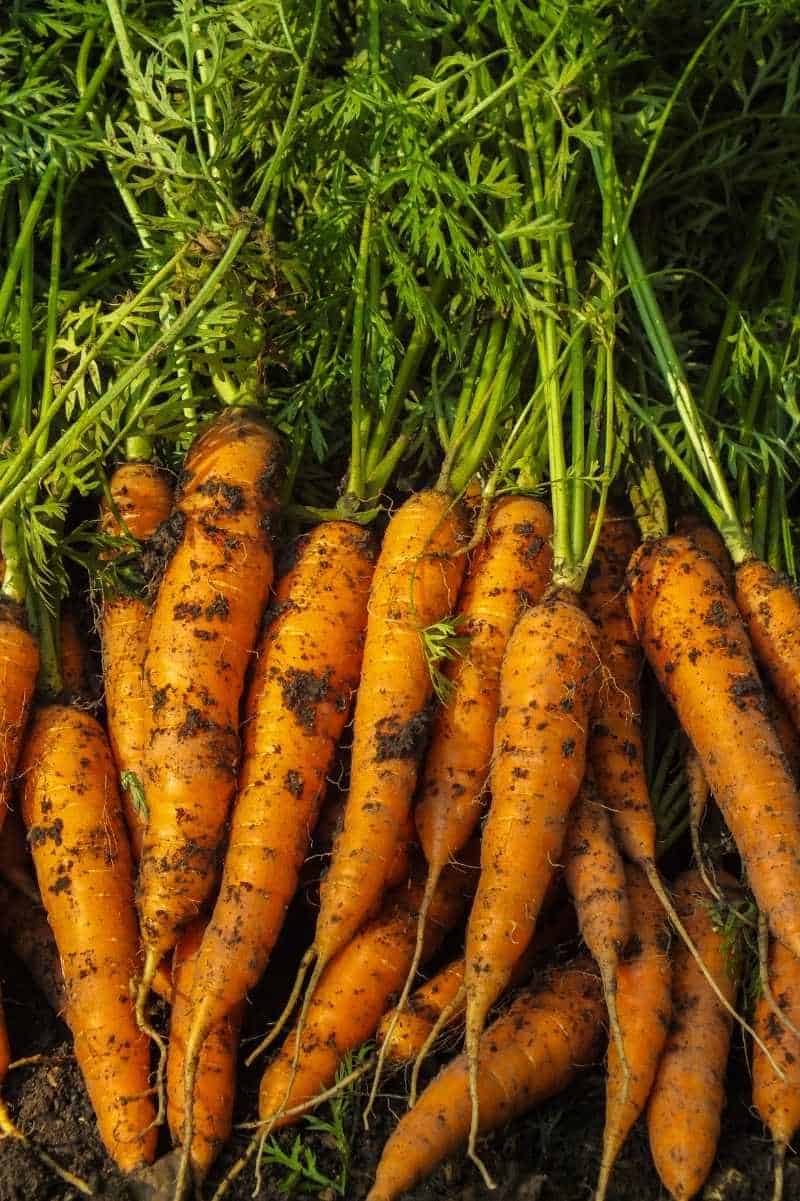
How to harvest carrots
For many varieties, carrots are sweetest when they’re harvested at ½ inch in diameter—that’s about the size of your thumb. If you let them grow too long, they can turn fibrous, thick, and tasteless. The younger the carrot is, the sweeter it will be. Leaving your carrots in the ground until the first frost is another trick for getting sweet carrots.
If your soil is sandy and loose, you can grab hold of the top of the carrot right near the root and gently twist and pull it from the ground. In harder soil, it’s best to use a trowel or garden fork to loosen the dirt around your carrots before attempting to pull them. Take a pair of garden scissors and cut off the carrot top an inch from the root. This little bit of stem will preserve your carrots for longer. You can also enjoy the carrot greens in pesto, salads, or sautéed!
Growfully Protip
Carrots are a biennial. This means you can leave them in the ground during the winter, and the following spring, their tops will produce more seeds.
How to store carrots
After harvesting, look for any carrots that are misshapen or damaged. Clean these carrots and store them in the fridge for immediate use. Store healthy carrots in a bin, box, or container in a cool, dry location such as a basement or root cellar. Layer the carrots in their box, alternating with a row of sand or sawdust. Stored properly, they’ll stay firm and fresh for several months.
You can also freeze and can carrots. Canned carrots require a pressure canner, but anyone can freeze carrots. As long as they’ve been blanched, frozen carrots should last up to a year in the freezer.
Growfully Protip
If you live in a milder climate, consider leaving your fully-grown carrots in the ground. In colder zones, cover them with an 18-inch layer of mulched leaves, and pull them as you need them. In milder zones, 6-12-inches of mulch should keep you in carrots all winter long.
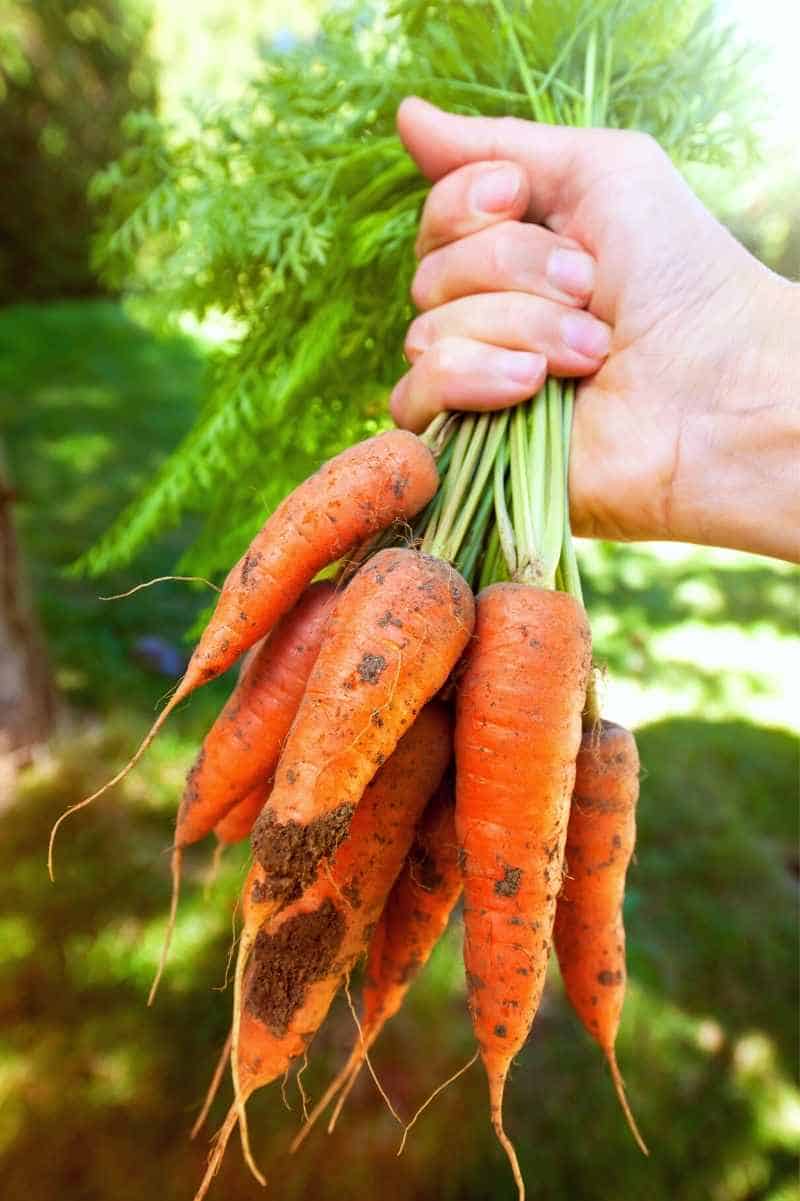
How to Grow Carrots
Materials
- Carrot seeds
- Loose, sandy soil
Instructions

- Loose soil required. Carrots need well-drained, sandy soil so that the vegetable can grow long and straight.
- Keep the soil moist. It is vital to keep the soil lightly damp while you wait for carrot seeds to germinate. If the soil dries out and crusts over, the carrot seedlings won't be able to push through.
- Use mulch. Carrots prefer cool roots and warm tops. A good layer of mulch around the vegetables will help achieve this.
- Thin carefully. Use a sharp pair of garden scissors to thin carrot seedlings and weed around young carrots. Baby carrot roots are very fragile and easily disturbed.
- Avoid nitrogen-rich fertilizers. Nitrogen-heavy fertilizers will do your carrots no favors. Instead, every six weeks, use a gentle, balanced fertilizer on carrots.
- Harvest young. Carrots are at their sweetest when harvested at 1/2" in diameter.

